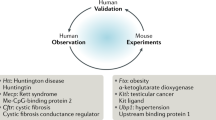
Overview
- Provides an excellent source for understanding the strength of the mouse as a model
- Includes essential background about mouse genetic engineering
- Covers the classic outbred and inbred mice as well as the latest genetically engineered mouse models
- Surveys a wide range of mouse human disease models
- Presents guidance from experimental design, techniques, and approaches to data analysis
- Describes the power of humanized mouse models
- Highlights thorough protocols and techniques accompanied by useful illustrations as provided by experts in the field
- Includes supplementary material: sn.pub/extras
Part of the book series: Methods in Molecular Biology (MIMB, volume 602)
Access this book
Tax calculation will be finalised at checkout
Other ways to access
About this book
As the drug discovery process shifts more and more toward specifically targeting pathways and molecules, model systems continue to increase in importance, and the mouse, with its versatility, ease of use, and remarkable similarity to the human genome, has clearly risen to the forefront of animal model studies. In Mouse Models for Drug Discovery: Methods and Protocols, experts in the field present some background for those less familiar with mice as experimental model platforms as well as a collection of techniques involving general methods as well as specific disease topics such as type 1 and 2 diabetes, cardiovascular disease, arthritis, skin disorders, cancer, the use of behavioral models for depression and anxiety, neurodegenerative diseases, neuromuscular diseases, and infectious diseases. Written in the highly successful Methods in Molecular Biology™ series format, chapters include introductions to their respective topics, lists of the necessary materials and reagents, step-by-step, readily reproducible laboratory protocols, and notes on troubleshooting and avoiding known pitfalls.
Authoritative and easy-to-use, Mouse Models for Drug Discovery: Methods and Protocols will stimulate those not familiar with the power of the mouse and its potential for the drug discovery process, and it will encourage the development of new models and new ways to utilize existing models in order to further the use of this dynamic animal in this vital field.
Similar content being viewed by others
Keywords
Table of contents (24 protocols)
-
Front Matter
Reviews
From the reviews:
“This book details methods for drug delivery and common measurements using mouse and disease models. … useful to those who are interested in using mouse models in their research, particularly for those diseases discussed in the book. … many of the methods will be useful across diverse areas of research. … useful for researchers using mice to study diseases, particularly if they want to use new procedures. The descriptions of how to administer drugs using various methods are presented well. … the book is helpful.” (Karen M. Kassel, Doody’s Review Service, July, 2010)Editors and Affiliations
Bibliographic Information
Book Title: Mouse Models for Drug Discovery
Book Subtitle: Methods and Protocols
Editors: Gabriele Proetzel, Michael V. Wiles
Series Title: Methods in Molecular Biology
DOI: https://doi.org/10.1007/978-1-60761-058-8
Publisher: Humana Totowa, NJ
eBook Packages: Springer Protocols
Copyright Information: Humana Press 2010
Hardcover ISBN: 978-1-60761-057-1Published: 17 December 2009
Softcover ISBN: 978-1-4939-6121-4Published: 23 August 2016
eBook ISBN: 978-1-60761-058-8Published: 10 December 2009
Series ISSN: 1064-3745
Series E-ISSN: 1940-6029
Edition Number: 1
Number of Pages: XII, 421
Topics: Pharmacology/Toxicology, Laboratory Medicine, Zoology, Animal Models



